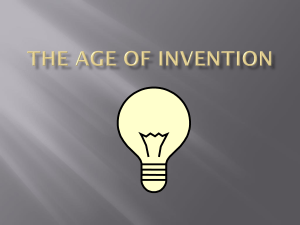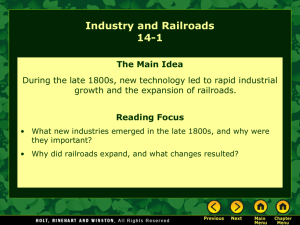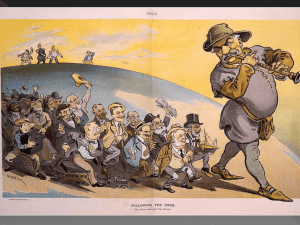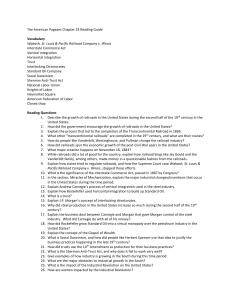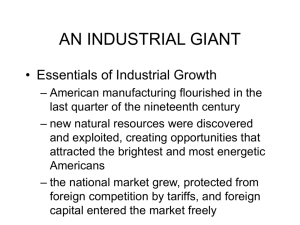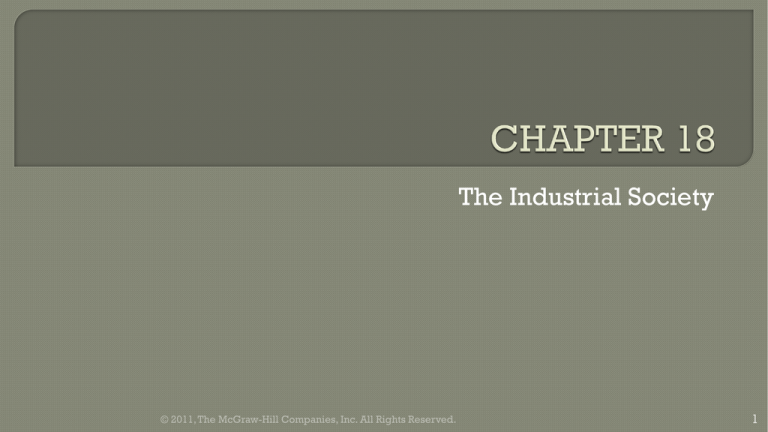
The Industrial Society
© 2011, The McGraw-Hill Companies, Inc. All Rights Reserved.
1
1. This man created a steel monopoly in the United States.
2. Founder of the Standard Oil Company
3. This is a board of directors/stockholders that coordinates companies
within an industry to avoid competition
4. Alexander Graham Bell invented the ______________.
5. This man invented the light bulb and the phonograph.
2
Late nineteenth-century U.S. offers ideal conditions for rapid
industrial growth
Abundance of cheap natural resources
Large pools of labor
Largest free trade market in the world
Capital, government support without regulation
Rapid growth 1865–1914
3
U.S.
industrial economy based on expansion of
the railroads
Steamships
made Atlantic crossings twice as fast
The
telegraph and telephone transformed
communications
4
Railroads
•
•
•
•
•
transform American life
End rural isolation
Allow regional economic specialization
Make mass production, consumption possible
Lead to organization of modern corporation
Stimulate other industries
Railroads
capture the imagination of the American people
5
1865–1916:
U.S. lays over 200,000 miles of track
costing billions of dollars
Expenses
Federal
met by government at all levels
railroad grants prompt corruption
• Credit Mobilier Scandal
What was this? Who was famously “involved” with this scandal?
1850–1945:
costs
Railroads save government $1 billion in freight
6
Federal
Land
Grants to
Railroads
as of 1871
By 1865, the US had as many mile of RR track as the rest of the world!
7
Railroad
Construction
1830–1920
8
No integrated rail system before Civil War
After 1860 construction and consolidation of trunk
lines proceeds rapidly
East linked directly with Great Lakes, West
• Union Pacific and Central Pacific
Railroads
Southern railroad system integrated in 1880s
Rail transportation becomes safe, fast, reliable
9
1862:
Congress authorizes the transcontinental railroad
Union
Pacific works westward from Nebraska using Irish laborers
Central
May
By
Pacific works eastward using Chinese immigrants
10, 1869: Tracks meet in Utah
1900, four more lines to Pacific
10
Union Pacific (East to West)
construction begins during Civil
War
Central Pacific (West to East)
begins after
Golden Spike driven in Ogden, Utah
1869
Promontory Point
Effect: Unites East and West;
Opens trade with Asia
Who wasn’t included in this picture?
Why not?
11
Railroads
1870 and
1890
© 2011, The McGraw-Hill Companies, Inc. All Rights Reserved.
12
Historian
Stephen Ambrose discusses the
Transcontinental Railroad:
VIDEO
13
Intense
Efforts
After
competition among railroads
to share freight in an orderly way fail
Panic of 1893, bankers gain control of railroad corporations
Bankers
impose order by consolidating to eliminate competition,
increase efficiency
14
Builds
financial empire through
railroads, banks, and holding
companies
Buys
out Carnegie and enters steel
business
Forms
US Steel Corporation – 1st ever
corporation worth more than $1
billion!
15
1.
Profiteering from the Civil War gives rise to millionaire
class
2.
Millionaires capitalize on Transcontinental railroad,
mechanization, industrialization, & expansion of
markets
3.
Surplus of raw materials, cheap labor, foreign
investment ENCOURAGE CAPITALISM
4.
Inventions Industrialization
More Inventions More Industrialization
ALL OF THIS GIVES RISE TO TYCOONS
16
The Manufacture of Iron
Manufacturing iron was a hot and
strenuous process, requiring
workers to spend longs hours
stoking hot blast furnaces.
(Library of Congress)
http://www.tiscali.co.uk/reference/encyclopaedia/hutchinson/images/c05312.jpg
Bessemer Process =
process to convert iron to steel
Copyright © Houghton Mifflin Company. All rights reserved.
17
Steel is King : US pouring out 1/3 of world’s
steel by 1890’s
“bootstrap” story: poor immigrant to tycoon
Carnegie uses vertical integration to make
more profit
• Controls all means of production, eliminates middle
man
Also uses horizontal consolidation to
eliminate competition.
Sells to JP Morgan for 400 million
Becomes a philanthropist
How do horizontal
consolidation and
vertical integration
help business??
18
Kerosene
and then Automobiles drive
up US oil consumption
Rockefeller
ruthlessly uses horizontal
consolidation to create largest
monopoly
1877
controls 95% of US’s oil refineries
Robber
Baron’s Baron
19
• Term used to describe industrialist of the late
1800’s
•Robber - referring to criminal or immoral
behavior
• Baron – referring to the illegitimate claim to
power of medieval lords of the manor.
• Anti-American
Standard Oil Monopoly
Believing that Rockefeller's Standard Oil monopoly was exercising dangerous
power, this political cartoonist depicts the trust as a greedy octopus whose sprawling
tentacles already ensnare Congress, state legislatures, and the taxpayer, and are
reaching for the White House. (Library of Congress)
Copyright © Houghton Mifflin Company. All rights reserved.
21
Wealthiest people
in the World
COMPARE:
Bill Gates - $56 BILLION
Monopoly = a firm that completely controls an industry
Vertical integration = combining all phases of manufacturing in to one
organization (Carnegie)
Horizontal consolidation = allying with competitors to monopolize a
market (Rockefeller)
Trust = a board of directors/stockholders that coordinates companies
within an industry to avoid competition
Holding company = a corporation composed of various competing
enterprises within one industry (JP Morgan’s US Steel)
23
Old
Rich displaced by rule of the “new
rich”
Gospel
of Wealth – discourages helping the
poor by state
Laissez
faire = “let it be”
Justified
by Social Darwinism – survival of
the fittest
Poor
are poor due to lack of initiative
26
This frequently reproduced cartoon, long
a staple of textbooks and studies of
Congress, depicts corporate interests–
from steel, copper, oil, iron, sugar, tin,
and coal to paper bags, envelopes, and
salt–as giant money bags looming over
the tiny senators at their desks in the
Chamber. Joseph Keppler drew the
cartoon, which appeared in Puck on
January 23, 1889, showing a door to the
gallery, the "people’s entrance," bolted
and barred. The galleries stand empty
while the special interests have floor
privileges, operating below the motto:
"This is the Senate of the Monopolists by
the Monopolists and for the Monopolists!"
Keppler’s cartoon reflected the
phenomenal growth of American industry
in the 1880s, but also the disturbing trend
toward concentration of industry to the
point of monopoly, and its undue
influence on politics. This popular
perception contributed to Congress’s
passage of the Sherman Anti-Trust Act in
1890.
The Trust Giant's Point of
View. "What a funny little
government" is a political
cartoon drawn by Horace
Taylor and originally
published in Verdict on
January 22. This source
depicts the corruption in the
United States congress
occurring because of vast
amounts of money held by
monopolies. This cartoon,
originally released to the
public, and for the public,
meant to increase awareness
of political corruption
resulting from monopolies.
Late
nineteenth-century industry leads to new American
technology
An
•
Age of Invention
Telegraph, camera, processed foods, telephone, phonograph,
incandescent lamp
How did each of these change society at the time?
Electricity
in growing use by 1900
30
31
Urbanization
Long Work
Children
Hours and Dangerous Jobs
work too
Women’s roles change
• Delayed marriages
• Smaller families
Accentuated class division
• 1900: 1/10 of US owns 9/10 of US’s wealth
• 1900: 2/3 of Americans are “wage slaves”
Workers’ lives
increasingly precarious
32
Factories took the skill out of many
positions
VERY dangerous
• 1882 – 675 laborers killed
• RRs – 1 in 300
Many women and children worked
to make ends meet
• What jobs did women work?
Children sacrificed their education
1899 – women earned $269 a
year/men earned $498
• That same year Carnegie made $23
million!!
34
Collective effort needed to counter
trusts
“An injury to one is an injury to all”
Founded as a secret society in
1869. Why?
Inclusive and Diverse:
Broad (utopian? Socialist?) goals
HURT by Haymarket Square riot,
1886, Chicago
• men and women
• white and black
• skilled and unskilled
Knights of Labor
Black delegate Frank J. Farrell introduces Terence V. Powderly, head of the
Knights of Labor, at the organization's 1886 convention. The Knights were
unusual in accepting both black and female workers. (Library of Congress)
37
1.
The Knights of Labor were weakened by
a.
Its refusal to endorse social reform and the 8 hour
day
Stiff competition from the National Labor Union
Its association in the public mind with the
Haymarket riot
Its inclusion of both skilled and unskilled workers
b.
c.
d.
38
Skilled workers split from Knights of Labor
1886
AF of L was elitist, narrow in goals – not
utopian
Led by Samuel Gompers used collective
bargaining
Avoided politics and focused on union goals:
• Better wages
• Eight-hour day
• Better working conditions
AF of L successful in many of its strikes and
in meeting many of its goals
39
**Pullman Strike – NBC Learn video
GREAT STRIKE
OF 1877
HAYMARKET
AFFAIR
1886
Railroad strike
Paralyzed rail
& commerce
Labor march
Bomb thrown
Several deaths
Pres. Hayes
Sent US troops
to end it
8 Anarchists
arrested
4 hanged,
1 suicide
CHINESE
EXCLUSION ACT
PUBLIC TURNS
AGAINST
LABOR
HOMESTEAD
STRIKE
1892
STEEL STRIKE
Protest work
& living
conditions
Pinkerton
Detectives
protect scabs,
Several deaths
US troops end it
WEAKENS
LABOR
PULLMAN STRIKE
1893
Pullman Comp.
cuts wages
during Panic
of 1893
Does not raise
after ends
Workers strike
US troops end it
Debs arrested
Workers
Blacklisted
LABOR WEAK
40



